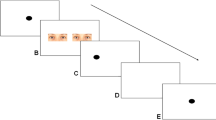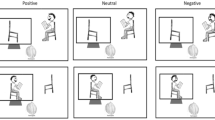Abstract
Gelotophobes are typically characterized by the fear of laughter, social withdrawal, and humorlessness, possibly related to negative experiences of being laughed at in the past. The present study seeks to expand our understanding of gelotophobia through a relatively novel approach: using eye-tracking to investigate the attentional bias of gelotophobes and non-gelotophobes towards negative emotion words that do and do not contain the Chinese character for “laugh,” by comparing responses to negative ridicule words (RID), negative contempt words (CONT), positive pleasure words (PLE) and neutral words (NEU). Results of the start time of the first run of fixations showed that gelotophobes and non-gelotophobes both focused on negative words before other words. Gelotophobes’ attentional bias towards RID and CONT was greater than that of non-gelotophobes in first gaze duration, percentage of total viewing duration, total fixation count, and run count, suggesting that gelotophobes had greater difficulty in disengaging their attention from negative to neutral words. Non-gelotophobes’ attentional bias, however, towards negative ridicule neutral words (RID-NEU) and negative contempt neutral words (CONT-NEU) was greater than that of gelotophobes, suggesting that non-gelotophobes were more able to shift attention from negative to neutral words. Moreover, gelotophobes paid significantly more attention to RID than CONT, suggesting that gelotophobes displayed a longer and stronger attentional bias towards RID (containing the “laugh” character). Interestingly, there was no difference for PLE between gelotophobes and non-gelotophobes. The present study contributes to our understanding of the attentional bias of gelotophobes and non-gelotophobes towards emotion words.



Similar content being viewed by others
References
Asmundson, G. J., & Stein, M. B. (1994). Selective processing of social threat in patients with generalized social phobia: Evaluation using a dot-probe paradigm. Journal of Anxiety Disorders, 8(2), 107–117.
Beck, A. T., Emery, G., & Greenberg, R. L. (1985). Anxiety disorders and phobias: A cognitive perspective. New York: Basic Books.
Bradley, B. P., Mogg, K., Millar, N., Bonham-Carter, C., Fergusson, E., Jenkins, J., et al. (1997). Attentional biases for emotional faces. Cognition and Emotion, 11, 25–42.
Chan, Y. C. (2015). The neural substrates of humor processing: An integrative review. Journal of Education and Psychology, 38(3), 101–135.
Chan, Y. C. (2016a). Neural correlates of deficits in humor appreciation in Gelotophobics. Scientific Reports, 6, 34580.
Chan, Y. C. (2016b). Neural correlates of sex/gender differences in humor processing for different joke types. Frontiers in Psychology, 7, 536.
Chan, Y. C., & Lavallee, J. P. (2015). Temporo-parietal and fronto-parietal lobe contributions to theory of mind and executive control: An fMRI study of verbal jokes. Frontiers in Psychology, 6, 1285.
Chan, Y. C., Chou, T. L., Chen, H. C., & Liang, K. C. (2012). Segregating the comprehension and elaboration processing of verbal jokes: An fMRI study. Neuroimage, 61(4), 899–906.
Chan, Y. C., Chen, H. C., & Lavallee, J. P. (2013a). The impact of gelotophobia, gelotophilia, and katagelasticism on creativity. Humor: International Journal of Humor Research, 26(4), 609–628.
Chan, Y. C., Chou, T. L., Chen, H. C., Yeh, Y. C., Lavallee, J. P., Liang, K. C., & Chang, K. E. (2013b). Towards a neural circuit model of verbal humor processing: An fMRI study of the neural substrates of incongruity detection and resolution. Neuroimage, 66, 169–176.
Chan, Y. C., Hsu, W. C., & Chou, T. L. (2018a). Dissociation between the processing of humorous and monetary rewards in the ‘motivation’ and ‘hedonic ‘brains. Scientific Reports, 8(1), 15425.
Chan, Y. C., Hsu, W. C., Liao, Y. J., Chen, H. C., Tu, C. H., & Wu, C. L. (2018b). Appreciation of different styles of humor: An fMRI study. Scientific Reports, 8(1), 15649.
Chen, H. C., Chan, Y. C., Ruch, W., & Proyer, R. T. (2011). Evaluating the reliability and validity of a traditional Chinese version of the PhoPhiKat-45. Psychological Testing, 58(1), 119–145.
Chen, H. C., Chan, Y. C., & Feng, Y. J. (2013a). Taiwan corpora of Chinese emotions and relevant psychophysiological data–a norm of emotion metaphors in Chinese. Chinese Journal of Psychology, 55(4), 525–553.
Chen, H. C., Chan, Y. C., Ruch, W., & Proyer, R. T. (2013b). Laughing at others and being laughed at in Taiwan and Switzerland: A cross-cultural perspective (volume II). In J. M. Davis & J. Chey (Eds.), Humour in Chinese life and culture: Resistance and control in modern times (pp. 215–229). Hong Kong: Hong Kong University Press.
Cho, S. L., Chen, H. C., & Cheng, C. M. (2013). Taiwan corpora of Chinese emotions and relevant psychophysiological data-a study on the norm of Chinese emotional words. Chinese Journal of Psychology, 55(4), 493–523.
Clark, D. M., & Wells, A. (1995). A cognitive model of social phobia. In R. G. Liebowitz, D. A. Hope, & F. R. Schneier (Eds.), Social phobia: Diagnosis, assessment, and treatment (pp. 69–93). New York: Guilford Press.
Edwards, K. R., Martin, R. A., & Dozois, D. J. A. (2010). The fear of being laughed at, social anxiety, and memories of being teased during childhood. Psychological Test and Assessment Modeling, 52, 94–107.
Feng, Y. J., Chan, Y. C., & Chen, H. C. (2014). Specialization of neural mechanisms underlying the three-stage model in humor processing: An ERP study. Journal of Neurolinguistics, 32, 59–70.
Haas, B. W., Omura, K., Constable, R. T., & Canli, T. (2007). Emotional conflict and neuroticism: Personality-dependent activation in the amygdala and subgenual anterior cingulate. Behavioral Neuroscience, 121(2), 249–256.
Hannus, M., & Hyönä, J. (1999). Utilization of illustrations during learning of science textbook passages among low-and high-ability children. Contemporary Educational Psychology, 24(2), 95–123.
Hegarty, M., Mayer, R. E., & Green, C. E. (1992). Comprehension of arithmetic word problems: Evidence from students’ eye fixations. Journal of Educational Psychology, 84(1), 76.
Heimberg, R. G., Lebowitz, M. R., Hope, D. A., & Schneier, F. R. (1995). Social phobia: Diagnosis, assessment, and treatment. New York: Guilford Press.
Hofmann, J., Platt, T., Ruch, W., & Proyer, R. (2015). Individual differences in gelotophobia predict responses to joy and contempt. SAGE Open, 5, 1–12.
Horenstein, M., & Segui, J. (1997). Chronometrics of attentional processes in anxiety disorders. Psychopathology, 30, 25–35.
Horley, K., Williams, L. M., Gonsalvez, C., & Gordon, E. (2004). Face to face: Visual scanpath evidence for abnormal processing of facial expressions in social phobia. Psychiatry Research, 127(1), 43–53.
Hu, Y. Q., Chiu, F. C., & Chen, H. C. (2014). Examining the phenomenon of negative attention Bias and exploring the effects of the materials with different valence on attention Bias modification training. Bulletin of Educational Psychology, 45(4), 435–454.
Koster, E. H. W., Crombez, G., Verschuere, B., & De Houwer, J. (2004). Selective attention to threat in the dot probe paradigm: Differentiating vigilance and difficulty to disengage. Behaviour Research and Therapy, 42, 1183–1192.
Lee, H. M., & Lee, Y. S. (2011). Emotionality ratings and free association of 267 common Chinese words. Formosa Journal of Mental Health, 24(4), 495–524.
Mansell, W., Ehlers, A., Clark, D. M., & Chen, Y. (2002). Attention to positive and negative social-evaluative words: Investigating the effects of social anxiety, trait anxiety and social threat. Anxiety Stress and Coping, 15, 19–29.
Mansell, W., Clark, D. M., & Ehlers, A. (2003). Internal versus external attention in social anxiety: An investigation using a novel paradigm. Behaviour Research and Therapy, 41, 555–572.
Mathews, A., Mogg, K., Kentish, J., & Eysenck, M. (1995). Effect of psychological treatment on cognitive bias in generalized anxiety disorder. Behaviour Research and Therapy, 33(3), 293–303.
Mogg, K., & Bradley, B. P. (2002). Selective orienting of attention to masked threat faces in social anxiety. Behaviour Research and Therapy, 40, 1403–1414.
Musa, C., Lepine, J., Clark, D. M., Mansell, W., & Ehlers, A. (2003). Selective attention in social phobia: The effect of a concurrent depressive disorder. Behaviour Research and Therapy, 41, 1043–1054.
O’Keefe, P. A., Letourneau, S. M., Homer, B. D., Schwartz, R. N., & Plass, J. L. (2014). Learning from multiple representations: An examination of fixation patterns in a science simulation. Computers in Human Behavior, 35, 234–242.
Papousek, I., Ruch, W., Freudenthaler, H. H., Kogler, E., Lang, B., & Schulter, G. (2009). Gelotophobia, emotion-related skills and responses to the affective states of others. Personality and Individual Differences, 47(1), 58–63.
Platt, T. (2008). Emotional responses to ridicule and teasing: Should gelotophobes react differently? Humor: International Journal of Humor Research, 21(2), 105–128.
Platt, T., & Ruch, W. (2009). The emotions of gelotophobes: Shameful, fearful, and joyless? Humor-International Journal of Humor Research, 22(1–2), 91–110.
Platt, T., Proyer, R. T., & Ruch, W. (2009). Gelotophobia and bullying: The assessment of the fear of being laughed at and its application among bullying victims. Psychological Test and Assessment Modeling, 51(2), 135.
Proyer, R. T., & Ruch, W. (2009). Intelligence and gelotophobia: The relations of self-estimated and psychometrically measured intelligence to the fear of being laughed at. Humor-International Journal of Humor Research, 22(1–2), 165–181.
Proyer, R. T., & Ruch, W. (2010). Dispositions towards ridicule and being laughed at: Current research on gelotophobia, gelotophilia, and katagelasticism. Psychological Test and Assessment Modeling, 52(1), 49–59.
Rawlings, D., Tham, T. A., & Davis, J. M. (2010). Gelotophobia, personality and emotion ratings following emotion-inducing scenarios. Psychological Test and Assessment Modeling, 52(2), 161–170.
Rayner, K. (1998). Eye movements in reading and information processing: 20 years of research. Psychological Bulletin, 124(3), 372–422.
Ritter, J., Brück, C., Jacob, H., Wildgruber, D., & Kreifelts, B. (2015). Laughter perception in social anxiety. Journal of Psychiatric Research, 60, 178–184.
Ruch, W. (2009). Fearing humor? Gelotophobia: The fear of being of laughed at introduction and overview. Humor: International Journal of Humor Research, 22(1/2), 1–25.
Ruch, W., & Proyer, R. T. (2008). Who is gelotophobic? Assessment criteria for the fear of being laughed at. Swiss Journal of Psychology, 67, 19–27.
Ruch, W., & Proyer, R. T. (2009). Who fears being laughed at? The location of gelotophobia in the PEN-model of personality. Personality and Individual Differences, 46, 627–630.
Ruch, W., Beermann, U., & Proyer, R. T. (2009). Investigating the humor of gelotophobes: Does feeling ridiculous equal being humorless? Humor-International Journal of Humor Research, 22(1–2), 111–143.
Ruch, W., Hofmann, J., Platt, T., & Proyer, R. (2014). The state-of-the art in gelotophobia research: A review and some theoretical extensions. Humor, 27(1), 23–45.
Ruch, W., Hofmann, J., & Platt, T. (2015). Individual differences in gelotophobia and responses to laughter-eliciting emotions. Personality and Individual Differences, 72, 117–121.
Samson, A. C., & Meyer, Y. (2010). Perception of aggressive humor in relation to gelotophobia, gelotophilia, and katagelasticism. Psychologycial Test and Assessment Modeling, 52(2), 217–230.
Titze, M. (1996). The Pinocchio complex: Overcoming the fear of laughter. Humor & Health Journal, 5(1), 1–11.
Titze, M. (2009). Gelotophobia: The fear of being laughed at. Humor-International Journal of Humor Research, 22(1–2), 27–48.
Tseng, M. I. (2009). Attention processing for threat face in social anxious individuals: Tests of Hypervigilance-avoidance hypothesis and Hypervigilance-difficult to disengagement hypothesis (unpublished thesis for Master’s degree). Taipei: National Chengchi University.
Acknowledgements
The authors thank the Cognitive and Human Affective Neuroscience Laboratory (CHAN Lab), National Tsing Hua University of Taiwan. The study was supported by the Yin Shu-Tien Educational Foundation. This work was also financially supported by a grant (MOST-108-2634-F-002-022) from the Ministry of Science and Technology of Taiwan, and by the “Institute for Research Excellence in Learning Sciences” and the “Chinese Language and Technology Center” of National Taiwan Normal University (NTNU), from the Featured Areas Research Center Program within the framework of the Higher Education Sprout Project of the Ministry of Education (MOE) in Taiwan.
Author information
Authors and Affiliations
Corresponding author
Ethics declarations
Competing Interests
On behalf of all authors, the corresponding author states that there are no conflicts of interest.
Compliance with Ethical Standards
The experiments described in this study were performed in accordance with relevant guidelines and regulations, under the supervision of the authors who have all received training in research ethics. Written obtained consent was obtained from all participants prior to participation.
Additional information
Publisher’s Note
Springer Nature remains neutral with regard to jurisdictional claims in published maps and institutional affiliations.
Rights and permissions
About this article
Cite this article
Lee, YL., Chen, HC. & Chan, YC. The attentional bias of gelotophobes towards emotion words containing the Chinese character for ‘laugh’: An eye-tracking approach. Curr Psychol 42, 16330–16343 (2023). https://doi.org/10.1007/s12144-019-00563-9
Published:
Issue Date:
DOI: https://doi.org/10.1007/s12144-019-00563-9




